Wireless Networking Concepts Assignment - Spring 2019 - University
VerifiedAdded on 2023/02/01
|6
|855
|87
Homework Assignment
AI Summary
This assignment solution covers key concepts in wireless networking. It begins with an explanation of cell splitting, including a diagram. The solution then calculates the reuse distance and the number of simultaneous calls supported per cell, given specific parameters such as bandwidth, channel m...
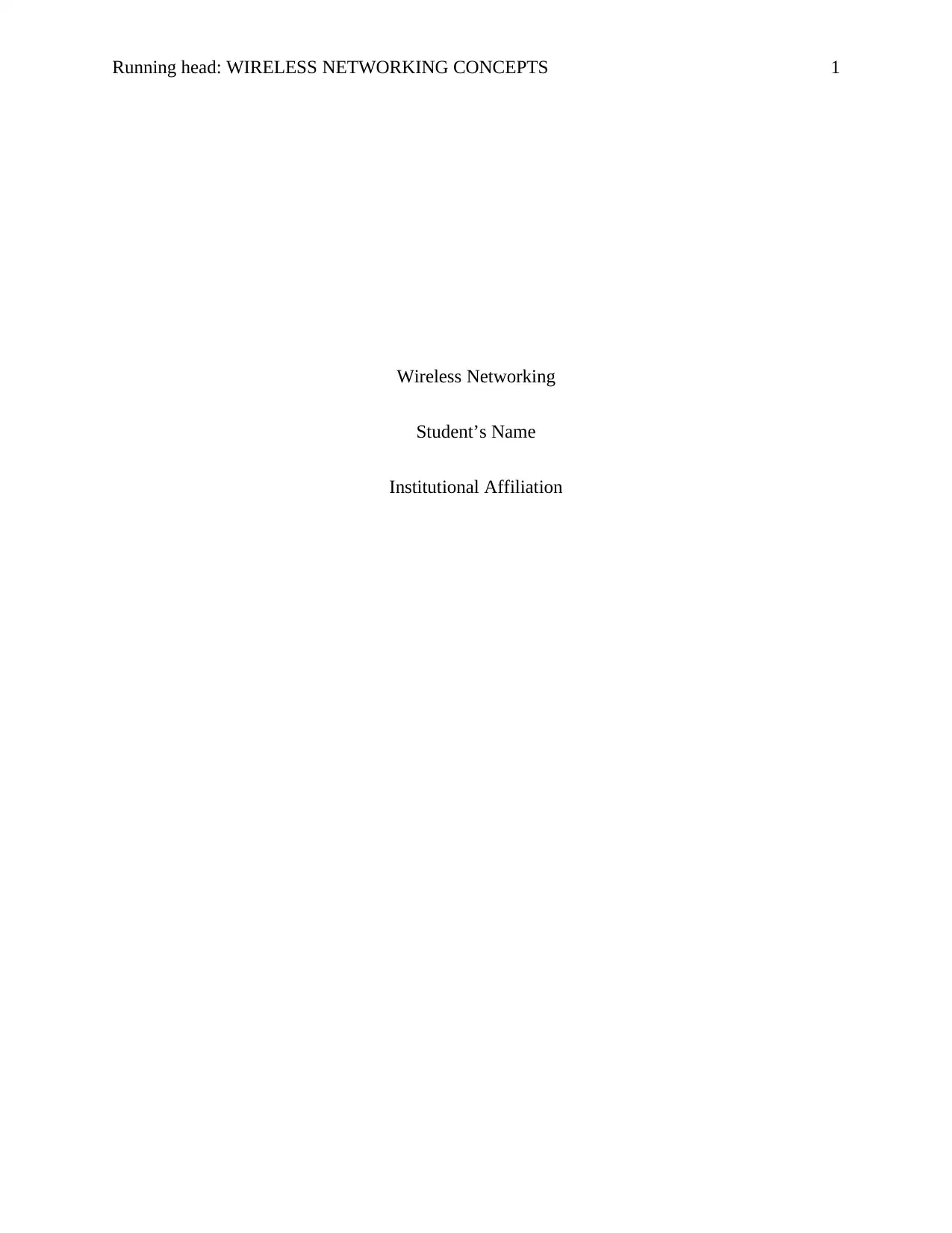
Running head: WIRELESS NETWORKING CONCEPTS 1
Wireless Networking
Student’s Name
Institutional Affiliation
Wireless Networking
Student’s Name
Institutional Affiliation
Paraphrase This Document
Need a fresh take? Get an instant paraphrase of this document with our AI Paraphraser
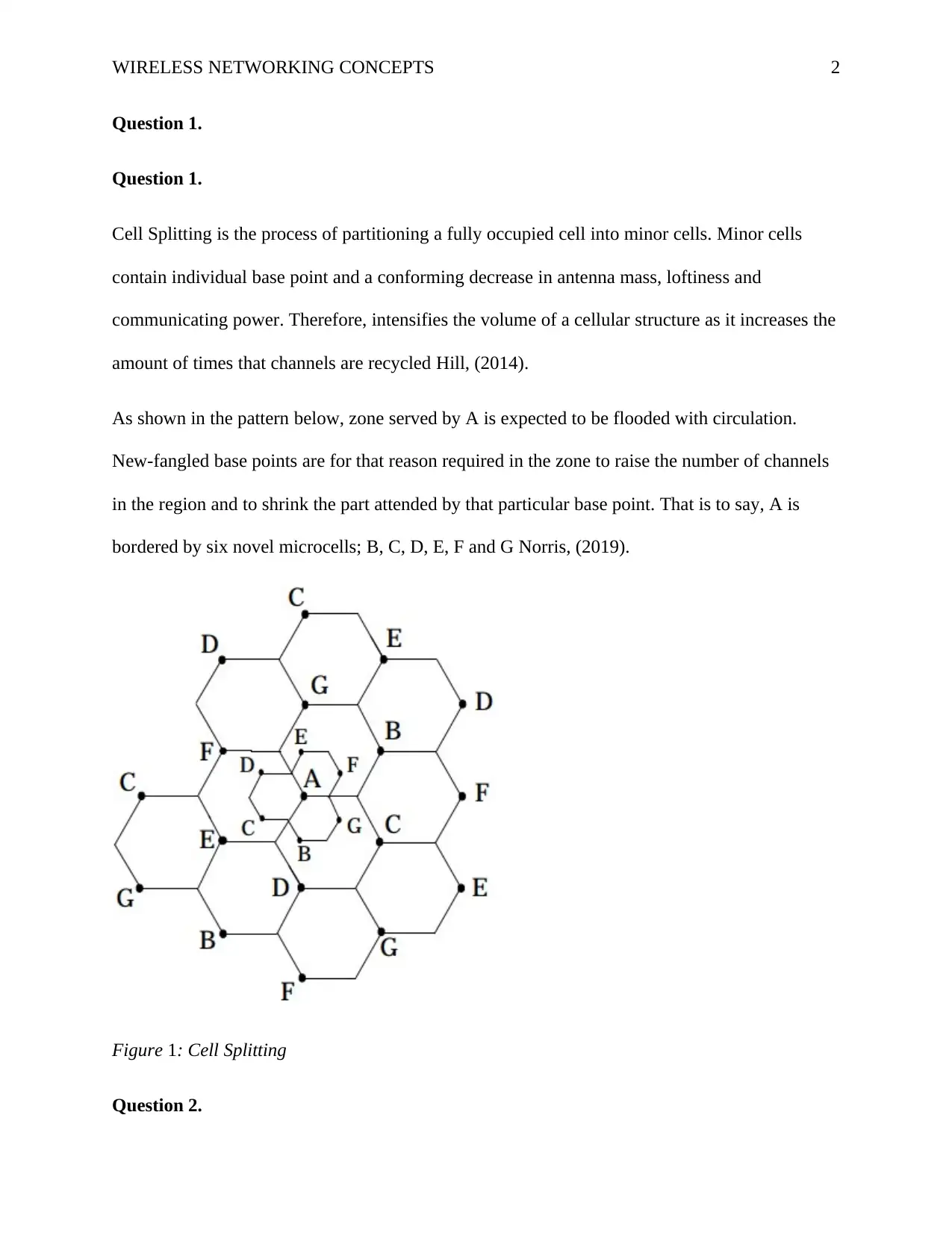
WIRELESS NETWORKING CONCEPTS 2
Question 1.
Question 1.
Cell Splitting is the process of partitioning a fully occupied cell into minor cells. Minor cells
contain individual base point and a conforming decrease in antenna mass, loftiness and
communicating power. Therefore, intensifies the volume of a cellular structure as it increases the
amount of times that channels are recycled Hill, (2014).
As shown in the pattern below, zone served by A is expected to be flooded with circulation.
New-fangled base points are for that reason required in the zone to raise the number of channels
in the region and to shrink the part attended by that particular base point. That is to say, A is
bordered by six novel microcells; B, C, D, E, F and G Norris, (2019).
Figure 1: Cell Splitting
Question 2.
Question 1.
Question 1.
Cell Splitting is the process of partitioning a fully occupied cell into minor cells. Minor cells
contain individual base point and a conforming decrease in antenna mass, loftiness and
communicating power. Therefore, intensifies the volume of a cellular structure as it increases the
amount of times that channels are recycled Hill, (2014).
As shown in the pattern below, zone served by A is expected to be flooded with circulation.
New-fangled base points are for that reason required in the zone to raise the number of channels
in the region and to shrink the part attended by that particular base point. That is to say, A is
bordered by six novel microcells; B, C, D, E, F and G Norris, (2019).
Figure 1: Cell Splitting
Question 2.

WIRELESS NETWORKING CONCEPTS 3
N=12 BW =30 MHz R=2 km
Control channelsfor each cell=10 number of operators for each channel=8
(i).
Reuse distance isdetermined by , D= √ ( 3 N ) ∗R
¿ √ ( 3∗12 )∗2=12 km
(ii).
Modest channel=25 kHZ
Channel bandwidth=25∗2=50 kHz
Number of channels for each cell=30000
50 − ( 10∗12 ) =480 channels
On the other hand, every channel is multiplexed between 8 operators, therefore the number of
concurrent calls supported for every cell is
¿ 480
12 ∗8=320 call for every cell .
(iii)
Regular number of call request for every hour =60
1hour= 1 x 60 x60
=3600sec
ƛ= 60
3600 = 1
60 requests for every sec
N=12 BW =30 MHz R=2 km
Control channelsfor each cell=10 number of operators for each channel=8
(i).
Reuse distance isdetermined by , D= √ ( 3 N ) ∗R
¿ √ ( 3∗12 )∗2=12 km
(ii).
Modest channel=25 kHZ
Channel bandwidth=25∗2=50 kHz
Number of channels for each cell=30000
50 − ( 10∗12 ) =480 channels
On the other hand, every channel is multiplexed between 8 operators, therefore the number of
concurrent calls supported for every cell is
¿ 480
12 ∗8=320 call for every cell .
(iii)
Regular number of call request for every hour =60
1hour= 1 x 60 x60
=3600sec
ƛ= 60
3600 = 1
60 requests for every sec
⊘ This is a preview!⊘
Do you want full access?
Subscribe today to unlock all pages.

Trusted by 1+ million students worldwide
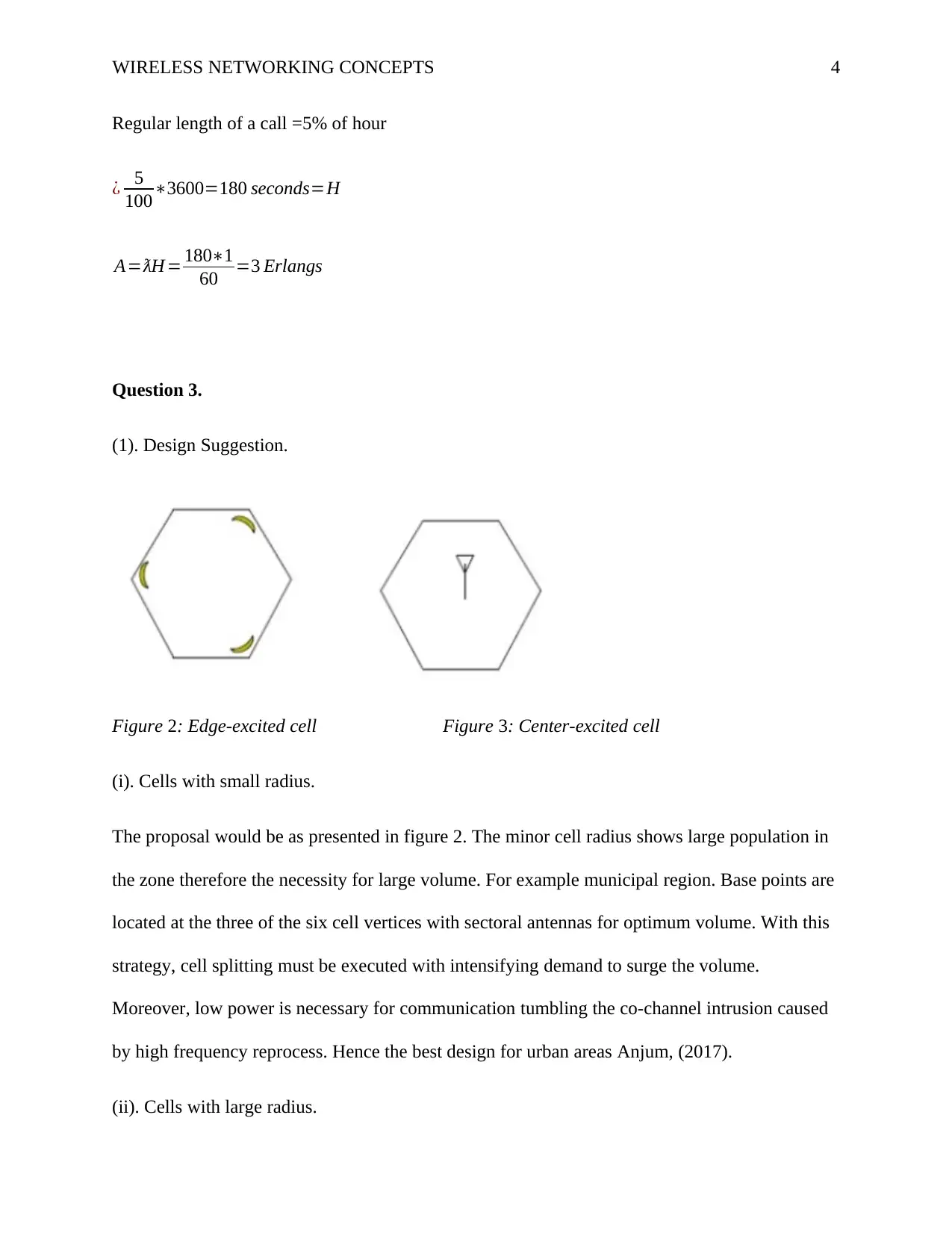
WIRELESS NETWORKING CONCEPTS 4
Regular length of a call =5% of hour
¿ 5
100∗3600=180 seconds=H
A=ƛH = 180∗1
60 =3 Erlangs
Question 3.
(1). Design Suggestion.
Figure 2: Edge-excited cell Figure 3: Center-excited cell
(i). Cells with small radius.
The proposal would be as presented in figure 2. The minor cell radius shows large population in
the zone therefore the necessity for large volume. For example municipal region. Base points are
located at the three of the six cell vertices with sectoral antennas for optimum volume. With this
strategy, cell splitting must be executed with intensifying demand to surge the volume.
Moreover, low power is necessary for communication tumbling the co-channel intrusion caused
by high frequency reprocess. Hence the best design for urban areas Anjum, (2017).
(ii). Cells with large radius.
Regular length of a call =5% of hour
¿ 5
100∗3600=180 seconds=H
A=ƛH = 180∗1
60 =3 Erlangs
Question 3.
(1). Design Suggestion.
Figure 2: Edge-excited cell Figure 3: Center-excited cell
(i). Cells with small radius.
The proposal would be as presented in figure 2. The minor cell radius shows large population in
the zone therefore the necessity for large volume. For example municipal region. Base points are
located at the three of the six cell vertices with sectoral antennas for optimum volume. With this
strategy, cell splitting must be executed with intensifying demand to surge the volume.
Moreover, low power is necessary for communication tumbling the co-channel intrusion caused
by high frequency reprocess. Hence the best design for urban areas Anjum, (2017).
(ii). Cells with large radius.
Paraphrase This Document
Need a fresh take? Get an instant paraphrase of this document with our AI Paraphraser
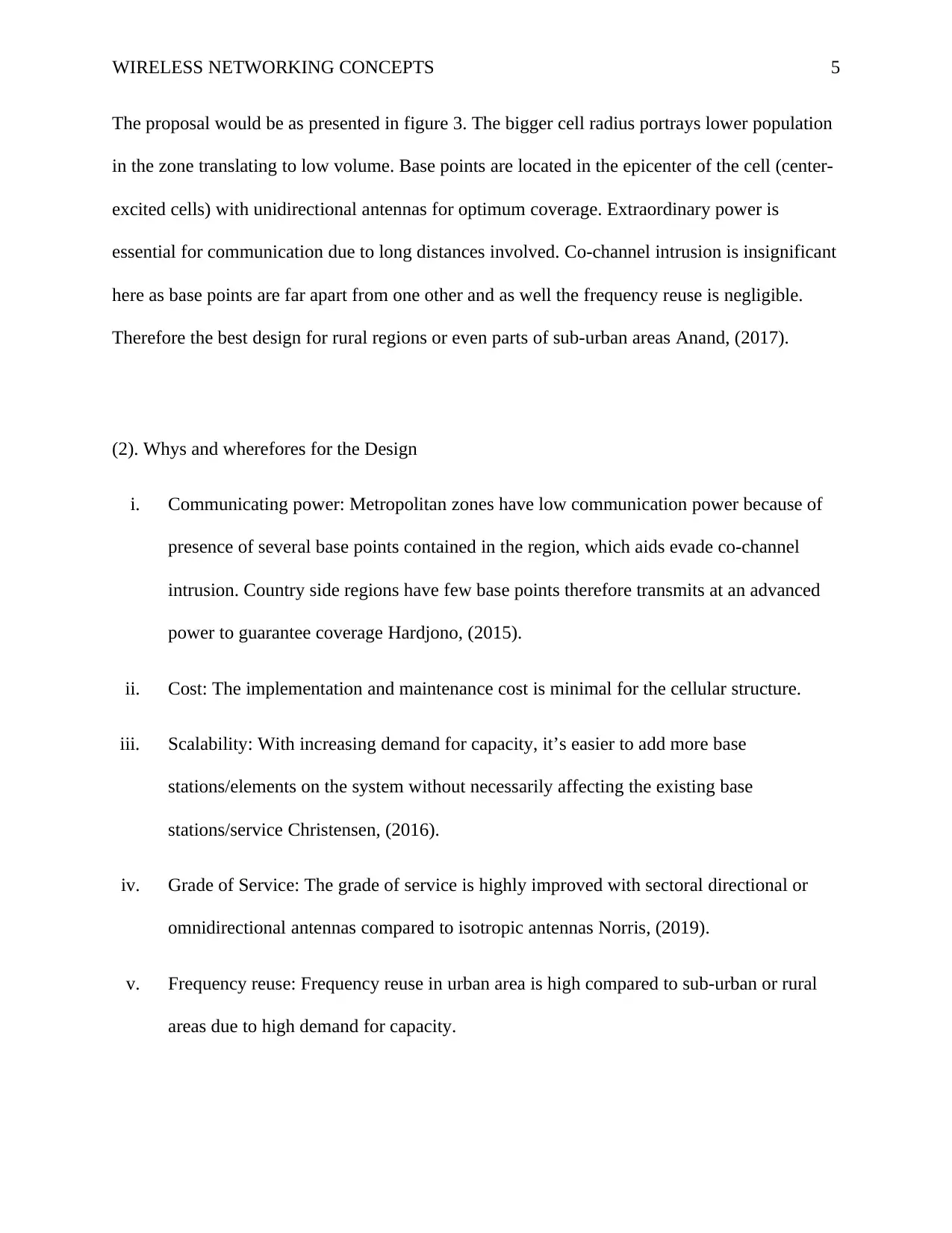
WIRELESS NETWORKING CONCEPTS 5
The proposal would be as presented in figure 3. The bigger cell radius portrays lower population
in the zone translating to low volume. Base points are located in the epicenter of the cell (center-
excited cells) with unidirectional antennas for optimum coverage. Extraordinary power is
essential for communication due to long distances involved. Co-channel intrusion is insignificant
here as base points are far apart from one other and as well the frequency reuse is negligible.
Therefore the best design for rural regions or even parts of sub-urban areas Anand, (2017).
(2). Whys and wherefores for the Design
i. Communicating power: Metropolitan zones have low communication power because of
presence of several base points contained in the region, which aids evade co-channel
intrusion. Country side regions have few base points therefore transmits at an advanced
power to guarantee coverage Hardjono, (2015).
ii. Cost: The implementation and maintenance cost is minimal for the cellular structure.
iii. Scalability: With increasing demand for capacity, it’s easier to add more base
stations/elements on the system without necessarily affecting the existing base
stations/service Christensen, (2016).
iv. Grade of Service: The grade of service is highly improved with sectoral directional or
omnidirectional antennas compared to isotropic antennas Norris, (2019).
v. Frequency reuse: Frequency reuse in urban area is high compared to sub-urban or rural
areas due to high demand for capacity.
The proposal would be as presented in figure 3. The bigger cell radius portrays lower population
in the zone translating to low volume. Base points are located in the epicenter of the cell (center-
excited cells) with unidirectional antennas for optimum coverage. Extraordinary power is
essential for communication due to long distances involved. Co-channel intrusion is insignificant
here as base points are far apart from one other and as well the frequency reuse is negligible.
Therefore the best design for rural regions or even parts of sub-urban areas Anand, (2017).
(2). Whys and wherefores for the Design
i. Communicating power: Metropolitan zones have low communication power because of
presence of several base points contained in the region, which aids evade co-channel
intrusion. Country side regions have few base points therefore transmits at an advanced
power to guarantee coverage Hardjono, (2015).
ii. Cost: The implementation and maintenance cost is minimal for the cellular structure.
iii. Scalability: With increasing demand for capacity, it’s easier to add more base
stations/elements on the system without necessarily affecting the existing base
stations/service Christensen, (2016).
iv. Grade of Service: The grade of service is highly improved with sectoral directional or
omnidirectional antennas compared to isotropic antennas Norris, (2019).
v. Frequency reuse: Frequency reuse in urban area is high compared to sub-urban or rural
areas due to high demand for capacity.
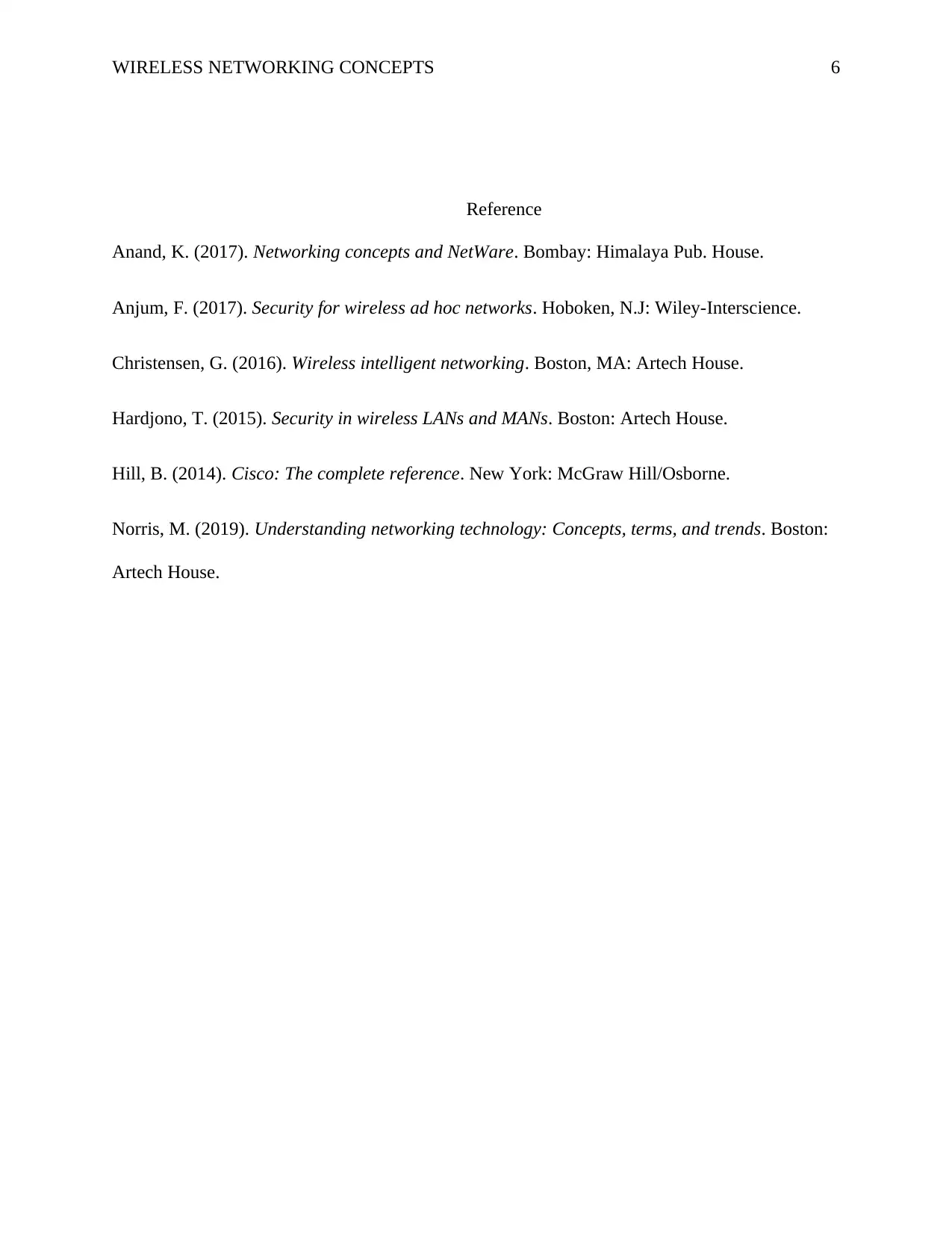
WIRELESS NETWORKING CONCEPTS 6
Reference
Anand, K. (2017). Networking concepts and NetWare. Bombay: Himalaya Pub. House.
Anjum, F. (2017). Security for wireless ad hoc networks. Hoboken, N.J: Wiley-Interscience.
Christensen, G. (2016). Wireless intelligent networking. Boston, MA: Artech House.
Hardjono, T. (2015). Security in wireless LANs and MANs. Boston: Artech House.
Hill, B. (2014). Cisco: The complete reference. New York: McGraw Hill/Osborne.
Norris, M. (2019). Understanding networking technology: Concepts, terms, and trends. Boston:
Artech House.
Reference
Anand, K. (2017). Networking concepts and NetWare. Bombay: Himalaya Pub. House.
Anjum, F. (2017). Security for wireless ad hoc networks. Hoboken, N.J: Wiley-Interscience.
Christensen, G. (2016). Wireless intelligent networking. Boston, MA: Artech House.
Hardjono, T. (2015). Security in wireless LANs and MANs. Boston: Artech House.
Hill, B. (2014). Cisco: The complete reference. New York: McGraw Hill/Osborne.
Norris, M. (2019). Understanding networking technology: Concepts, terms, and trends. Boston:
Artech House.
⊘ This is a preview!⊘
Do you want full access?
Subscribe today to unlock all pages.

Trusted by 1+ million students worldwide
1 out of 6
Related Documents
Your All-in-One AI-Powered Toolkit for Academic Success.
+13062052269
info@desklib.com
Available 24*7 on WhatsApp / Email
![[object Object]](/_next/static/media/star-bottom.7253800d.svg)
Unlock your academic potential
© 2024 | Zucol Services PVT LTD | All rights reserved.





